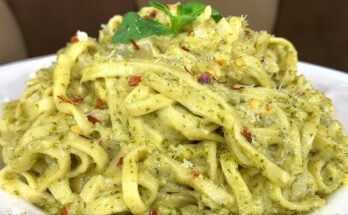Chicken Kabobs Recipe: Chicken kabobs are the ultimate crowd-pleaser. They’re juicy, flavorful, colorful, and incredibly versatile. Whether grilled, baked, or cooked over a stovetop, chicken kabobs are a go-to dish that combines protein and veggies on one stick. It’s a meal and a presentation all in one. The real charm lies in their simplicity and the explosion of flavor in each bite. You can customize them with different marinades and sides, making them suitable for both everyday dinners and festive gatherings.
Moreover, they’re healthy! Packed with lean protein, fiber-rich vegetables, and minimal oil, chicken kabobs are a balanced option for anyone watching their diet. It’s no surprise they’re a staple in Mediterranean, Middle Eastern, and American cuisines alike.
And let’s not forget the fun part—food on a stick! It adds a casual, hands-on element to any meal. Whether it’s a BBQ party or a family dinner, chicken kabobs bring everyone together around the grill.
Perfect Occasions for Serving Chicken Kabobs
Chicken kabobs are as adaptable as they are delicious. They fit in beautifully at summer cookouts, family gatherings, potlucks, picnics, or even weeknight dinners. Planning a backyard BBQ? Kabobs are a no-brainer. Hosting a game night? Serve kabobs as finger food with dips on the side.
They’re also ideal for meal prep. Make a big batch, and you’ve got lunches or dinners ready to go. Since they reheat well, they’re perfect for leftovers too. Want to impress guests? Serve your kabobs over a bed of rice pilaf or alongside a fresh Greek salad for a restaurant-quality meal at home.
Ingredients You’ll Need
Main Ingredients for the Chicken Kabobs
To make the best chicken kabobs, you’ll need fresh, high-quality ingredients. Here’s what to gather:
- Chicken Breast or Thighs (2 lbs): Boneless, skinless chicken is ideal. Thighs offer more flavor and juiciness, while breasts are leaner.
- Bell Peppers (Red, Yellow, Green): They add sweetness and vibrant color.
- Red Onion: Slightly sweet when grilled and adds texture.
- Zucchini or Yellow Squash: Offers a nice balance of crunch and moisture.
- Olive Oil: Helps keep everything moist and enhances flavor.
- Garlic: Fresh minced garlic adds a deep, savory note.
- Lemon Juice: Adds brightness and helps tenderize the meat.
- Salt & Pepper: Essential for seasoning.
- Paprika, Cumin, or Oregano: Choose your preferred spice profile.
This basic combination creates a delicious medley of flavors and textures. Each ingredient plays its part in making these kabobs a mouthwatering delight.
Optional Add-Ins for Extra Flavor
If you want to elevate your kabobs, consider these tasty additions:
- Cherry Tomatoes: Sweet and juicy, they burst with flavor after grilling.
- Mushrooms: Add a meaty bite that complements chicken well.
- Pineapple Chunks: Introduce a tropical sweetness that balances the savory.
- Marinade Variations: Try a yogurt-based marinade for a Mediterranean twist or a teriyaki blend for Asian-inspired kabobs.
These add-ons not only enhance the flavor but also add a pop of color and excitement to your presentation.
Tools and Equipment Required
Must-Have Tools for Kabob Preparation
You don’t need a commercial kitchen setup to make great chicken kabobs. A few basic tools will do:
- Cutting Board & Sharp Knife: For chopping meat and veggies with precision.
- Mixing Bowls: To prepare and marinate the ingredients.
- Skewers: Metal or wooden skewers work, depending on your cooking method.
- Grill or Grill Pan: Essential for that smoky, charred flavor.
- Tongs: Makes flipping kabobs safe and easy.
Optional tools like a meat thermometer help ensure your chicken is cooked perfectly without drying out.
Tips for Using Skewers Effectively
If using wooden skewers, soak them in water for 30 minutes before grilling. This prevents burning. Metal skewers are reusable and heat up, helping cook the meat from the inside.
When skewering, leave a bit of space between pieces for even cooking. Overcrowding leads to steamed rather than grilled food. Also, try grouping ingredients by cooking time—this ensures nothing is over or undercooked.
Preparing the Chicken Marinade
Ingredients for the Marinade
A flavorful marinade is the soul of a great chicken kabob. Here’s a simple, zesty version:
- 1/4 cup olive oil
- Juice of 2 lemons
- 3 garlic cloves (minced)
- 1 tbsp paprika
- 1 tsp ground cumin
- 1 tsp dried oregano
- 1 tsp salt
- 1/2 tsp black pepper
Combine all the ingredients in a bowl or zip-lock bag and stir well to create a balanced marinade. It should be tangy, aromatic, and slightly spicy—perfect for infusing your chicken with flavor.
Tips for Perfectly Marinating Chicken
Marinate your chicken for at least 1 hour, but 4-6 hours is ideal for maximum flavor. If you’re short on time, even 30 minutes can make a difference. Avoid marinating for more than 24 hours, as the acid in the marinade can start to break down the meat, making it mushy.
Make sure every piece is well-coated and covered in the fridge. Flip the pieces halfway through for even marination. You can also reserve a bit of the marinade before adding raw chicken to use later as a basting sauce.
Assembling the Chicken Kabobs
Best Vegetables to Pair with Chicken
When assembling kabobs, balance is key. You want veggies that complement the chicken without overpowering it. Bell peppers, onions, zucchini, and mushrooms are top choices for both taste and durability on the grill. They’re colorful, hearty, and soak up marinade flavors beautifully.
Avoid soft vegetables like tomatoes unless you’re grilling quickly. They tend to fall apart or overcook easily. Pineapple, while technically a fruit, makes a great sweet counterpart to savory chicken if you’re feeling adventurous.
Layering Tips for Juicy and Colorful Kabobs
Presentation matters! Alternate chicken and veggies for a rainbow effect. This isn’t just pretty—it ensures even cooking and lets flavors mingle. Here’s a solid sequence: red pepper, chicken, onion, zucchini, chicken, yellow pepper, and repeat.
Don’t pack the skewers too tightly. A bit of space between pieces lets heat circulate, giving you those gorgeous grill marks and juicy bites. Once skewered, let the kabobs sit at room temperature for 10-15 minutes before cooking—this helps them cook evenly.
Cooking the Chicken Kabobs
Grilling Method – Best for Flavor
Grilling chicken kabobs is hands down the best way to get that smoky, charred flavor. Preheat your grill to medium-high heat—around 375°F to 400°F. Once hot, place your kabobs on the grill and cook for about 12 to 15 minutes, turning every few minutes for even browning.
The trick is not to overcook the chicken. Use a meat thermometer to check for doneness; the internal temperature should reach 165°F. If you’re using vegetables that cook quickly, like tomatoes or mushrooms, consider skewering them separately to prevent burning.
For a little extra zing, brush your kabobs with reserved marinade during grilling. Just make sure this marinade hasn’t touched raw chicken. That final glaze layer adds shine and boosts flavor.
Grilling also gives those iconic sear marks we all love, along with a crispy texture that contrasts beautifully with the juicy interior of the chicken.
Oven-Baked Kabobs – A Great Indoor Option
No grill? No problem. Oven-baked kabobs are just as delicious. Preheat your oven to 425°F, line a baking sheet with foil, and place a wire rack on top. Lay your kabobs on the rack to allow air to circulate and roast evenly.
Bake for 20 to 25 minutes, flipping halfway through. Broil the kabobs during the last 2-3 minutes to give them a slight char. The oven method works well in colder months or when grilling outdoors isn’t an option.
One advantage here? Consistency. The oven ensures an even cook across all your kabobs, especially if you’re making a big batch. Just keep an eye on the chicken so it doesn’t dry out.
Serving Suggestions for Chicken Kabobs
Best Side Dishes to Complement Your Kabobs
Chicken kabobs are versatile, and so are their sidekick dishes. Here are some winning combos:
- Rice Pilaf: A classic pairing, especially with Mediterranean flavors.
- Grilled Corn or Asparagus: Smoky and satisfying.
- Couscous or Quinoa Salad: Light, healthy, and perfect for summer.
- Hummus & Pita Bread: For a Middle Eastern twist.
- Tzatziki or Garlic Yogurt Sauce: Adds creaminess and cools down the spices.
- Roasted Potatoes or Sweet Potatoes: Hearty and filling.
Want to keep it light? Serve kabobs over a fresh green salad with feta and olives. Craving something hearty? A side of creamy mashed potatoes or buttery naan will hit the spot.
Creative Plating and Garnishing Ideas
Presentation matters—especially if you’re serving guests. Here’s how to make your kabobs Instagram-worthy:
- Layer skewers over a wooden platter sprinkled with chopped parsley or cilantro.
- Add lemon wedges for a fresh, zesty garnish.
- Serve with colorful dipping sauces like chimichurri, aioli, or spicy tahini.
- For parties, consider a DIY kabob station, letting guests build their own from prepped ingredients.
Small touches like these elevate a simple dish into something truly memorable.
Storing and Reheating Chicken Kabobs
How to Store Leftovers Properly
Got leftovers? No worries—kabobs store well and make fantastic next-day meals. First, remove the chicken and veggies from the skewers to save space and avoid them drying out. Store them in an airtight container in the fridge.
They’ll stay fresh for up to 3-4 days. Make sure the chicken is cooled to room temperature before refrigerating to avoid condensation that can lead to sogginess.
For longer storage, kabobs can be frozen. Spread them out on a baking sheet, freeze until solid, then transfer to a zip-lock bag or freezer-safe container. They’ll keep for about 2 months.
Reheating Without Losing Flavor
To reheat, avoid the microwave if you can—it can turn your juicy chicken into rubber. Instead:
- Stovetop: Sauté in a non-stick pan over medium heat with a little olive oil.
- Oven: Reheat at 350°F for 10–12 minutes, covered with foil to retain moisture.
- Air Fryer: A quick 5-6 minutes at 375°F gives you crispy edges and tender meat.
If using frozen kabobs, thaw them in the fridge overnight before reheating. A splash of lemon juice or a dollop of sauce helps revive the flavors.
Common Mistakes to Avoid
Overcooking the Chicken
The biggest mistake? Overcooked chicken. Dry, tough meat is no one’s idea of delicious. Keep an eye on your cooking time, and always use a thermometer to ensure accuracy. Once it hits 165°F, it’s done.
Let the kabobs rest for a few minutes before serving. This locks in the juices and enhances flavor.
Skipping the Marinade
A bland kabob is a sad kabob. Don’t skip the marinade or rush the process. Even 30 minutes can make a difference. For deeper flavor, marinate overnight.
Avoid acidic marinades for too long—lemon or vinegar-based ones can break down the protein and turn your chicken mushy.
Healthy Twists on Chicken Kabobs
Low-Carb and Keto-Friendly Versions
If you’re following a low-carb or keto lifestyle, chicken kabobs can easily fit into your meal plan. Skip starchy vegetables like potatoes or corn and instead load your skewers with:
- Zucchini
- Bell peppers
- Mushrooms
- Cauliflower
- Cherry tomatoes (in moderation)
Swap sugary marinades for herb-based or oil-based ones. A marinade with olive oil, lemon juice, garlic, and fresh herbs like thyme or rosemary is both keto-friendly and incredibly flavorful. You can also use Greek yogurt as a base for marination—it’s low in carbs and gives the chicken a creamy texture.
Pair your kabobs with a side of cauliflower rice or a crunchy cucumber salad, and you’ve got a healthy, satisfying, low-carb meal.
Gluten-Free Options for Sensitive Eaters
Chicken kabobs are naturally gluten-free if you’re cautious with your ingredients. Most fresh veggies and chicken cuts are safe, but you’ll need to watch out for hidden gluten in sauces or spice blends.
Use gluten-free soy sauce or tamari if you’re doing an Asian-inspired version. Double-check any store-bought marinades or spice mixes to ensure they don’t contain wheat-based thickeners or flavorings.
You can even make your own gluten-free spice rub with smoked paprika, garlic powder, cumin, and oregano. Serve your kabobs with gluten-free sides like roasted veggies or rice pilaf for a worry-free dinner.
Variations of Chicken Kabobs from Around the World
Mediterranean Chicken Kabobs
Mediterranean kabobs are a festival of flavors. The chicken is typically marinated in a mix of olive oil, lemon juice, garlic, oregano, and a bit of yogurt. This marinade not only tenderizes the meat but also infuses it with tangy, herby goodness.
Pair with cherry tomatoes, red onions, and zucchini for a classic touch. Serve over couscous, with a side of hummus and tzatziki, and sprinkle feta cheese on top for the full experience.
Don’t forget the warm pita bread. Wrap the kabob in it with a drizzle of tahini or hot sauce for a delicious Mediterranean-style wrap.
Asian-Inspired Chicken Skewers
Looking for something with a punch of umami and sweetness? Asian chicken kabobs are the way to go. Use a marinade of soy sauce, sesame oil, garlic, ginger, and honey or brown sugar. Add chili flakes for a spicy kick.
Thread the chicken with pineapple chunks, red bell peppers, and green onions. Grill until caramelized, and garnish with sesame seeds and chopped scallions. Serve with jasmine rice or stir-fried noodles.
For dipping sauce, consider a peanut sauce or sweet chili sauce—both pair perfectly with the salty-sweet profile of these kabobs.
Tips for Making Kabobs Kid-Friendly
Fun Ingredients Kids Will Love
Kids eat with their eyes first, so make kabobs colorful and playful. Think bell peppers in different colors, juicy cherry tomatoes, and even fruit like mango or pineapple. Keep the spice level low and use simple marinades—something like olive oil, lemon juice, a little garlic, and salt.
You can also get creative with shapes. Use mini cookie cutters for veggies like zucchini or cheese slices to add some fun.
Cut everything into bite-sized pieces so kids can enjoy the kabobs without needing a knife. Using mini skewers or even toothpicks for small kabob “bites” works great for little hands.
Getting Kids Involved in the Cooking Process
Let kids help with assembling the kabobs. Set up a DIY kabob station with bowls of pre-cut ingredients and let them build their own. It turns dinner into a fun activity and makes them more excited to eat what they helped create.
Cooking together also helps kids learn about different foods and builds healthy eating habits. Just make sure an adult handles the grill or oven part.
FAQs about Chicken Kabobs Recipe
1. Can I prepare chicken kabobs ahead of time?
Yes! You can marinate the chicken and assemble the skewers a day ahead. Store them covered in the fridge until you’re ready to cook.
2. How do I keep the chicken from drying out on the grill?
Marinate the chicken well, don’t overcook, and use a thermometer to pull them off the grill at exactly 165°F.
3. Can I cook kabobs without a grill?
Absolutely! You can bake them in the oven at 425°F or even use a stovetop grill pan for similar results.
4. What are the best vegetables for kabobs?
Bell peppers, onions, zucchini, cherry tomatoes, mushrooms, and even pineapple chunks are all great choices.
5. How long should I marinate chicken for kabobs?
At least 1 hour, but 4–6 hours is ideal. Don’t exceed 24 hours, especially with acidic marinades.
Conclusion
Chicken kabobs are the perfect blend of flavor, versatility, and simplicity. Whether you’re grilling them in the backyard, baking them in the oven, or serving them at a party, they never disappoint. With just a handful of ingredients and some simple techniques, you can whip up a dish that’s juicy, colorful, and bursting with flavor.
The beauty of kabobs lies in their adaptability—you can change up the marinade, swap out the veggies, or even give them an international flair. Whether you’re keeping it classic with Mediterranean flavors or going bold with Asian spices, there’s a version out there for everyone.
Best of all? They’re fun to eat and fun to make. So grab some skewers, fire up the grill (or the oven), and treat yourself to a meal that’s as exciting as it is delicious.



